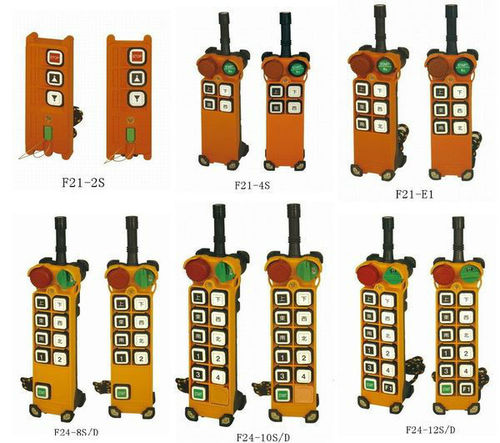
CRANE RADIO REMOTE CONTROL
उत्पाद विवरण:
- टाइप करें ईओटी
- मटेरियल थर्माप्लास्टिक
- दूरी को नियंत्रित करें 100 मीटर (m)
- काम करने की आवृत्ति 50 हर्ट्ज (एचजेड)
- इनपुट पावर 110 वोल्ट (V)
- फ़्रिक्वेंसी (मेगाहर्ट्ज) 50 हर्ट्ज (एचजेड)
- रंग पीले नारंगी
- Click to view more
रेडियो रिमोट कंट्रोल सिस्टम मूल्य और मात्रा
- 1
- सेट/सेट्स
रेडियो रिमोट कंट्रोल सिस्टम उत्पाद की विशेषताएं
- पीले नारंगी
- 1 वर्ष
- ईओटी
- थर्माप्लास्टिक
- 50 हर्ट्ज (एचजेड)
- 110 वोल्ट (V)
- 50 हर्ट्ज (एचजेड)
- 100 मीटर (m)
रेडियो रिमोट कंट्रोल सिस्टम व्यापार सूचना
- कैश ऑन डिलीवरी (COD) चेक
- 50 प्रति सप्ताह
- 4 दिन
- Yes
- नमूना लागत, शिपिंग और करों का भुगतान खरीदार द्वारा किया जाना है
- कसकर भरा हुअ
- ऑल इंडिया
- एक आईएसओ 9001: 2008 प्रमाणित कंपनी
उत्पाद विवरण
We offer our client an excellent quality range of Tower Crane Radio Remote Control, which are manufactured from high grade quality raw materials. These products can be customized as per our precious customers specifications. These Remote Control are widely known for its durability and quality.
| Product Specification | |
| Product Name | Crane Radio Remote Control Systems |
| Product Code | 23 |
| Place of Origin | Rajkot, Gujarat, Indiaï |
| Product rangeï | (2+1,4+2,6+2,8+2 ) Single & Double Speed both |
| Advantages | Low Maintenance, Easy Installation |
| Application | |
| Order Details | |
| Packaging Details | As Per Requirement |
| Delivery Time | 10 to 15 Days |
| Port | Mundra, Gujarat, India |
| Minimum Order Quantity | 1 PSC |
| Supply Ability | Any |
| Payment tearms | 100% Advance |
ï
Radio Remote Control FAQ:
Q. What is a radio remote control?
Ans: A radio remote control is a device that utilizes radio frequency signals to wirelessly operate or control various equipment, machinery, vehicles, or devices from a distance.
Q. How does a radio remote control work?
Ans: Radio remote controls consist of a transmitter and a receiver. The transmitter sends radio signals containing control commands, which are received by the receiver. The receiver then interprets these signals and activates the corresponding functions or movements in the controlled device.
Q. What types of devices can be controlled with a radio remote control?
Ans: Radio remote controls are used to operate a wide range of equipment, including cranes, hoists, industrial machinery, robotics, drones, model cars, boats, airplanes, home automation systems, and more.
Q. What are the advantages of using radio remote controls?
Ans: Radio remote controls offer the flexibility of controlling devices from a distance, enhancing safety by allowing operators to control equipment from a safer location. They also provide convenience and ease of use, particularly in applications where direct physical access is difficult or hazardous.
Q. Are radio remote controls secure?
Ans: Most modern radio remote controls use secure digital communication protocols to prevent unauthorized access or interference. Encryption and authentication methods are often employed to ensure the security of transmitted signals.
Q. What is the range of a typical radio remote control?
Ans: The range of a radio remote control can vary depending on factors such as the frequency used, environmental conditions, and interference. In general, typical ranges can range from a few meters to several hundred meters or more.
Q. What are the different types of radio frequencies used in remote controls?
Ans: Radio remote controls can operate on various frequencies, including 27MHz, 433MHz, 900MHz, 2.4GHz, and others. The choice of frequency depends on factors such as range requirements, interference levels, and regulatory considerations.
Q. Can radio remote controls operate multiple devices?
Ans: Yes, many radio remote controls are capable of controlling multiple devices or functions through the use of channels or modes. This allows operators to manage several pieces of equipment with a single remote control unit.
Q. How do you maintain and troubleshoot radio remote controls?
Ans: Maintenance typically involves regular inspection, cleaning, and battery replacement as needed. Troubleshooting may involve checking for signal interference, ensuring proper antenna orientation, inspecting connections, and verifying power sources.
Q. Are there any regulations or certifications for radio remote controls?
Ans: Depending on the application and location, radio remote controls may need to comply with specific regulations and standards, such as FCC regulations in the United States or CE certification in the European Union, to ensure compliance with safety and electromagnetic compatibility requirements.

Price: Â
- 50
- 100
- 200
- 250
- 500
- 1000+
 08045801632
08045801632
 English
English Spanish
Spanish French
French German
German Italian
Italian Chinese (Simplified)
Chinese (Simplified) Japanese
Japanese Korean
Korean Arabic
Arabic Portuguese
Portuguese




 जांच भेजें
जांच भेजें एसएमएस भेजें
एसएमएस भेजें
